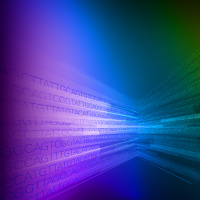NGS library prep from ssDNA—the ssDNA-Seq Kit

Prepare high-quality libraries from single-stranded DNA (ssDNA) species that are not captured during conventional double-stranded DNA (dsDNA) library preparation. The ssDNA-Seq Kit enables the construction of DNA libraries from both ssDNA and dsDNA and is ideal for samples that often contain a mixture of both DNA species, including FFPE DNA, DNA from environmental sources, and damaged or degraded DNA samples.
Prepare high-quality libraries from single-stranded DNA (ssDNA) that are not captured during conventional double-stranded DNA (dsDNA) library preparation. The ssDNA-Seq Kit enables the construction of DNA libraries from both ssDNA and dsDNA and is ideal for samples that often contain a mixture of both DNA species, including FFPE DNA, DNA from environmental sources, and damaged or degraded DNA samples.
The kit is compatible with DNA inputs as low as 10 pg and ssDNA fragments as short as 50 bp. Unlike traditional dsDNA-seq workflows, the ssDNA-seq Kit workflow begins with the conversion of all DNA species within the sample to ssDNA through a pretreatment and heat denaturation step. Following heat denaturation, Single-Strand DNA Ligase is used to add the first adaptor to the 3’ ends of all ssDNA fragments. The library is converted to dsDNA through primer extension, and the second adaptor is added to the 5’ ends of the dsDNA fragments. Finally, Unique Dual Indexes (Cat. # 634752–634756; sold separately) are used to add the indexing sequences needed for Illumina sequencing, and the library is amplified. This simple workflow can be completed in less than 2 hr.
Overview
- Construct Illumina-ready NGS libraries from both ssDNA and dsDNA
- Use with highly fragmented, damaged, or degraded DNA, including FFPE samples
- Enable analysis of ssDNA fragments as short as 50 bp
- Complete library prep in under 2 hr with a simple workflow
- Multiplex up to 384 samples with Unique Dual Index Kit compatibility
The ssDNA-Seq Kit is compatible with many DNA forms not captured by traditional library prep kits
| DNA form | Compatible with the ssDNA-Seq Kit? | Compatible with traditional dsDNA library prep kits? |
| dsDNA | ||
| ssDNA | Χ | |
| dsDNA with nicks/gaps | Χ | |
| dsDNA with 5’ overhangs | Χ | |
| dsDNA with 3’ overhangs | Χ |
More Information
Applications
Use in the analysis of:
- ssDNA
- dsDNA
- Genomic DNA
- Cell-free DNA
- Ultra-short DNA
- Synthetic oligos
- FFPE DNA
- Environmental DNA
- Viral DNA
- Ancient DNA
- DNA aptamers
Additional product information
Please see the product's Certificate of Analysis for information about storage conditions, product components, and technical specifications. Please see the Kit Components List to determine kit components. Certificates of Analysis and Kit Components Lists are located under the Documents tab.
Takara Bio USA, Inc.
United States/Canada: +1.800.662.2566 • Asia Pacific: +1.650.919.7300 • Europe: +33.(0)1.3904.6880 • Japan: +81.(0)77.565.6999
FOR RESEARCH USE ONLY. NOT FOR USE IN DIAGNOSTIC PROCEDURES. © 2025 Takara Bio Inc. All Rights Reserved. All trademarks are the property of Takara Bio Inc. or its affiliate(s) in the U.S. and/or other countries or their respective owners. Certain trademarks may not be registered in all jurisdictions. Additional product, intellectual property, and restricted use information is available at takarabio.com.



